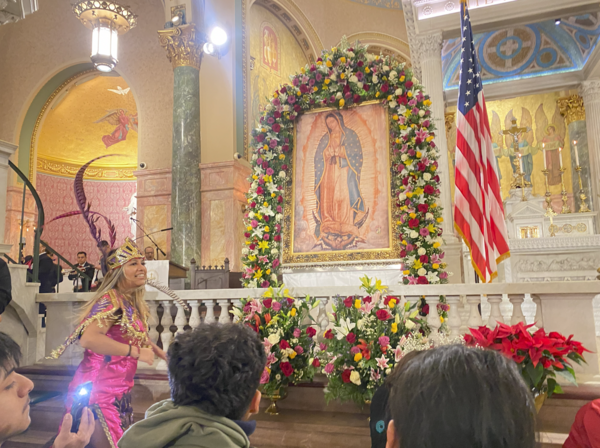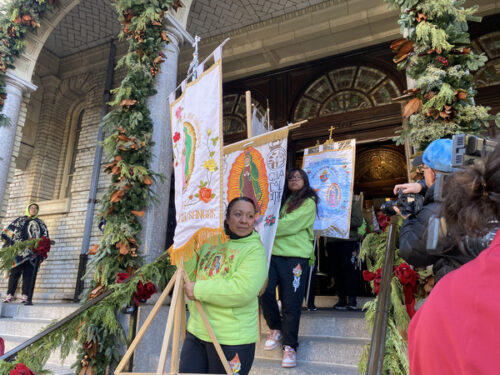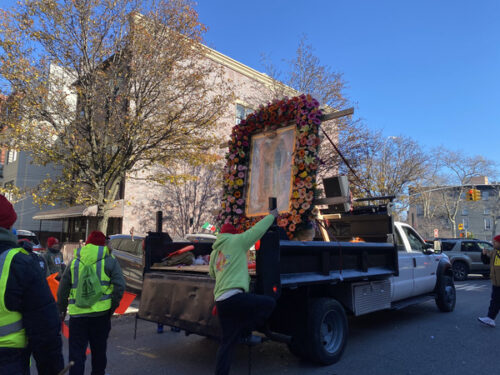
PROSPECT HEIGHTS — Sharing talents with others is part of being a good steward of the gifts given by God.
During the feast of Our Lady of Guadalupe on Dec. 12, the Co-Cathedral of St. Joseph was filled with not only the passion and devotion of nearly 1,500 devotees — also known as Guadalupanos — but also artful demonstrations of tradition.
From the rose-covered altar and replicas of the 16th-century image of Our Lady of Guadalupe to traditional music and dance, the feast was abundant with cultural imagery, a component central to the celebration.
“Mexican culture is very rich in symbol and in music,” said Auxiliary Bishop Emeritus Octavio Cisneros, nodding to the Feast of Our Lady of Guadalupe’s roots in Mexico in 1531, when the Blessed Virgin Mary appeared to Juan Diego on the hill of Tepeyac. “Each culture has something that enriches our hearts, and the Blessed Mother comes with our culture to infuse the presence of Christ in our lives.”
The Mass began with a high-energy dance routine led by a group of dancers wearing traditional Aztec dress.
New York’s chapter of Ballet Folklorico Quetzalcoatl danced in the cathedral’s aisles, filling the room with the sounds of the cascabels on their ankles. The Brooklyn-based performance group has been active for 23 years and is powered by dancers of all ages.
Director Benito Bravo’s dance journey began in his hometown of Puebla, Mexico, before he moved to New York City in 1992.
“There are many forms of traditional Mexican dance, but danza Azteca is reserved for sacred ceremonies, such as the Feast of Our Lady of Guadalupe. The tradition comes from thousands of years ago, which we still honor today,” he said. “That’s why it’s very important that we include the young people in the Mexican dance tradition, to keep it alive.”
Bishop Cisneros echoed this sentiment in his homily, which called for young people to answer God’s calls to the Church and its traditions.
“Dancing in this group is important to me and my Catholic faith because we’re dancing for Christ,” said Kaila Martinez, a 19-year-old member of the group. “Today, we’re specifically dancing for Our Lady of Guadalupe. It’s her feast day, and I’m happy to be part of the tradition.”
The feast’s devotees were serenaded by the sounds of Mariachi Nuevo Sol, a Brooklyn-based mariachi band.
The eight-piece band played songs so familiar to devotees they were able to sing along, such as “Buenos Días Paloma Blanca, “La Guadalupana,” and “Himno A La Humildad.”
Javier Garcia, the band’s director and violin player, said he performs in this Mass as a way to express gratitude, devotion, and respect to the Blessed Virgin Mary.
“These songs are so special to us because it unites us as a culture and as Mexicans,” Garcia said, reflecting on his move to New York from Puebla, Mexico, 25 years ago. “It feels great to see everyone happy and singing along, and it’s been great to do so in the community over the last 10 years.”
The Feast of Our Lady of Guadalupe remains a mainstay in Mexican and other Hispanic communities as years go on, reflected by the charred torches representative of past years celebrated.
The art that comes with the tradition is a welcomed and vibrant component of the experience, said Bishop Robert Brennan, who led devotees in Mass.
“Mexican culture is deeply, deeply rooted in faith … so all of the music, the art, the dancing, it’s all rooted in that experience of faith,” he said. “God is the supreme artist.”


